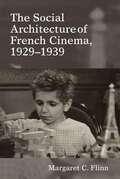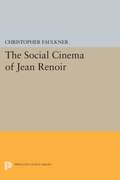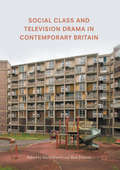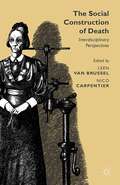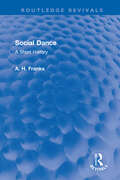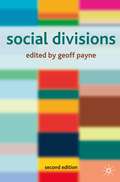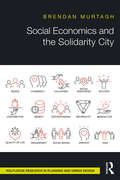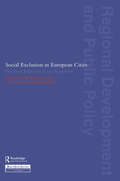- Table View
- List View
The Social Architecture of French Cinema: 1929–1939 (Contemporary French and Francophone Cultures #34)
by Margaret FlinnFrom the fleetingly captured street scenes of the city symphony, to the meticulously reconstructed studio city of musical comedies; from the propagandistic Popular Front documentaries about construction workers, to poetic realism’s bittersweet portraits of populist neighborhoods: Social Architecture explores the construction, representation and experience of spaces and places in documentary and realist films of the French 1930s. In this book, Margaret C. Flinn tracks the relation between the emergent techniques of French sound cinema and its thematic, social and political preoccupations through analysis of discourse in contemporary press, theoretical texts and through readings of films themselves. New light is shed on works of canonical directors such as Renoir, Clair, Vigo and Duvivier by their consideration in relationship to little known documentary films of the era. Flinn argues that film has a readable architecture—a configuration of narrative and representations that informs, explains, and creates social identities, while reflecting upon the position of individuals within their societies.
The Social Cinema of Jean Renoir
by Christopher FaulknerReinterpreting twelve of Renoir's best-known works, Professor Faulkner attributes their qualities not to the director's unified sensibility but to varying social and historical circumstances.Originally published in 1986.The Princeton Legacy Library uses the latest print-on-demand technology to again make available previously out-of-print books from the distinguished backlist of Princeton University Press. These editions preserve the original texts of these important books while presenting them in durable paperback and hardcover editions. The goal of the Princeton Legacy Library is to vastly increase access to the rich scholarly heritage found in the thousands of books published by Princeton University Press since its founding in 1905.
Social Class and Television Drama in Contemporary Britain
by Beth Johnson David ForrestThis collection is a wide-ranging exploration of contemporary British television drama and its representations of social class. Through early studio-set plays, soap operas and period drama, the volume demonstrates how class provides a bridge across multiple genres and traditions of television drama. The authors trace this thematic emphasis into the present day, offering fascinating new insights into the national conversation around class and identity in Britain today. The chapters engage with a range of topics including authorial explorations of Stephen Poliakoff and Jimmy McGovern, case studies of television performers Maxine Peake and Jimmy Nail, and discussions of the sitcom genre and animation form. This book offers new perspectives on popular British television shows such as Goodnight Sweetheart and Footballers’ Wives, and analysis of more recent series such as Peaky Blinders and This is England.
The Social Construction of Death: Interdisciplinary Perspectives
by Leen Van Brussel Nico CarpentierChapter 12 of this book is open access under a CC BY license. Well-established scholars from a variety of disciplines - including sociology, anthropology, media and cultural studies, and political sciences – use the social construction of death and dying to analyse a wide variety of meaning-making practices in societal fields such as ethics, politics, media, medicine and family.
The Social Context of James Ensor’s Art Practice: “Vive La Sociale!”
by Susan M. Canning“Vive la Sociale”: This rousing, revolutionary statement, written on a bright red banner across the top of James Ensor's Christ's Entry into Brussels in 1889, served as a visual manifesto and call to action by the Belgian artist (1860-1949), one that announced with an insistent, public voice the centrality of his art practice to the cultural discourse of modern Belgium. This provocative declaration serves as the title for this new study of Ensor's art focusing on its social discourse and the artist's interaction with and at times satirical encounter with his contemporary milieu. Rather than the alienated and traumatized Expressionist given preference in modern art history, Ensor is presented here as an artist of agency and purpose whose art practice engaged the issues and concerns of middle class Belgian life, society and politics and was informed by the values and class, race and gendered perspectives of his time. Ensor's radical vision and oppositional strategy of resistance, self-fashioning and performance remains relevant. This book with its timely, nuanced reading of the art and career of this often misunderstood “artist's artist”, invites a re-evaluation not only of Ensor's social context and expressive critique but also his unique contribution to modernist art practice.
The Social Context of James Ensor’s Art Practice: “Vive La Sociale!”
by Susan M. Canning“Vive la Sociale”: This rousing, revolutionary statement, written on a bright red banner across the top of James Ensor's Christ's Entry into Brussels in 1889, served as a visual manifesto and call to action by the Belgian artist (1860-1949), one that announced with an insistent, public voice the centrality of his art practice to the cultural discourse of modern Belgium. This provocative declaration serves as the title for this new study of Ensor's art focusing on its social discourse and the artist's interaction with and at times satirical encounter with his contemporary milieu. Rather than the alienated and traumatized Expressionist given preference in modern art history, Ensor is presented here as an artist of agency and purpose whose art practice engaged the issues and concerns of middle class Belgian life, society and politics and was informed by the values and class, race and gendered perspectives of his time. Ensor's radical vision and oppositional strategy of resistance, self-fashioning and performance remains relevant. This book with its timely, nuanced reading of the art and career of this often misunderstood “artist's artist”, invites a re-evaluation not only of Ensor's social context and expressive critique but also his unique contribution to modernist art practice.
Social Dance: A Short History (Routledge Revivals)
by Arthur FranksOriginally published in 1963 and authored by the then Editor of the Dancing Times, this was a pioneer work discussing not only the origins and development of many social dance forms from early times, but also relating these forms to their environment. As well as its role in social history, the book analyses the role of dance as a prime creative power in Renaissance spectacles which depicted and celebrated diplomatic, military and regal occasions. After a wide-ranging introductory chapter on the origins of dancing, the book takes the reader through the centuries, discussing in turn the Basse Danse and the Moresco of the Middle Ages, the Pavane, Galliard and Courante of the 16th Century, the Minuet of the 17th & 18th, the Allemande, the Waltz and the Polka as well as Jazz, the Cha Cha Cha, the Jive and Twist.
Social Dance: A Short History (Routledge Revivals)
by Arthur FranksOriginally published in 1963 and authored by the then Editor of the Dancing Times, this was a pioneer work discussing not only the origins and development of many social dance forms from early times, but also relating these forms to their environment. As well as its role in social history, the book analyses the role of dance as a prime creative power in Renaissance spectacles which depicted and celebrated diplomatic, military and regal occasions. After a wide-ranging introductory chapter on the origins of dancing, the book takes the reader through the centuries, discussing in turn the Basse Danse and the Moresco of the Middle Ages, the Pavane, Galliard and Courante of the 16th Century, the Minuet of the 17th & 18th, the Allemande, the Waltz and the Polka as well as Jazz, the Cha Cha Cha, the Jive and Twist.
The Social Design Reader
by Elizabeth ResnickThe Social Design Reader explores the ways in which design can be a catalyst for social change. Bringing together key texts of the last fifty years, editor Elizabeth Resnick traces the emergence of the notion of socially responsible design. This volume represents the authentic voices of the thinkers, writers and designers who are helping to build a 'canon' of informed literature which documents the development of the discipline.The Social Design Reader is divided into three parts. Section 1: Making a Stand includes an introduction to the term 'social design' and features papers which explore its historical underpinnings. Section 2: Creating the Future documents the emergence of social design as a concept, as a nascent field of study, and subsequently as a rapidly developing professional discipline, and Section 3: A Sea Change is made up of papers acknowledging social design as a firmly established practice.Contextualising section introductions are provided to aid readers in understanding the original source material, while summary boxes clearly articulate how each text fits with the larger milieu of social design theory, methods, and practice.
The Social Design Reader
by Elizabeth ResnickThe Social Design Reader explores the ways in which design can be a catalyst for social change. Bringing together key texts of the last fifty years, editor Elizabeth Resnick traces the emergence of the notion of socially responsible design. This volume represents the authentic voices of the thinkers, writers and designers who are helping to build a 'canon' of informed literature which documents the development of the discipline.The Social Design Reader is divided into three parts. Section 1: Making a Stand includes an introduction to the term 'social design' and features papers which explore its historical underpinnings. Section 2: Creating the Future documents the emergence of social design as a concept, as a nascent field of study, and subsequently as a rapidly developing professional discipline, and Section 3: A Sea Change is made up of papers acknowledging social design as a firmly established practice.Contextualising section introductions are provided to aid readers in understanding the original source material, while summary boxes clearly articulate how each text fits with the larger milieu of social design theory, methods, and practice.
Social Diversity within Multiliteracies: Complexity in Teaching and Learning
by Fenice B. Boyd Cynthia H. BrockUsing a multiliteracies theoretical framework highlighting social diversity and multimodality as central in the process of meaning making, this book examines literacy teaching and learning as embedded in cultural, linguistic, racial, sexual, and gendered contexts and explores ways to foster learning and achievement for diverse students in various settings. Attending simultaneously to topics around two overarching and interrelated themes—languages and language variations, and cultures, ethnicities, and identities—the chapter authors examine the roles that multiliteracies play in students’ lives in and out of classrooms. In Part I, readers are asked to examine beliefs and dispositions as related to different languages, language varieties, cultures, ethnicities, and identities. Part II engages readers in examining classroom and community practices related to different languages and language varieties, cultures, ethnicities, and identities.
Social Diversity within Multiliteracies: Complexity in Teaching and Learning
by Fenice B. Boyd Cynthia H. BrockUsing a multiliteracies theoretical framework highlighting social diversity and multimodality as central in the process of meaning making, this book examines literacy teaching and learning as embedded in cultural, linguistic, racial, sexual, and gendered contexts and explores ways to foster learning and achievement for diverse students in various settings. Attending simultaneously to topics around two overarching and interrelated themes—languages and language variations, and cultures, ethnicities, and identities—the chapter authors examine the roles that multiliteracies play in students’ lives in and out of classrooms. In Part I, readers are asked to examine beliefs and dispositions as related to different languages, language varieties, cultures, ethnicities, and identities. Part II engages readers in examining classroom and community practices related to different languages and language varieties, cultures, ethnicities, and identities.
Social Divisions
Society consists of people sharply divided from one another, living different lives and with distinct identities. This updated and expanded second edition of a successful text explores each of the social divisions. The book includes three major new chapters, on religion, poverty and elites and is written by leading academics in each field.
Social Economics and the Solidarity City
by Brendan MurtaghSocial Economics and the Solidarity City explores the impact and potential of the social economy as a site of urban struggle, political mobilization and community organization. The search for alternatives to the neoliberal logic governing contemporary cities has often focused on broad and ill-defined political, social and environmental movements. These alternatives sometimes fail to connect with the lived realities of the city or to change the lives of those exploited in neoliberal restructuring. This book seeks to understand the capacity of the social economy to revitalize urban ethics, local practices and tangible political alterity. Providing a critical account of the social economy and its place in urban and state restructuring, this book draws on a range of international cases to argue that the social economy can be made a transformative space. Evaluating community enterprises, social finance, and solidarity economics, author Brendan Murtagh maps the possibilities, contradictions and tactics of moving the rhetoric of the just city into local and global action.
Social Economics and the Solidarity City
by Brendan MurtaghSocial Economics and the Solidarity City explores the impact and potential of the social economy as a site of urban struggle, political mobilization and community organization. The search for alternatives to the neoliberal logic governing contemporary cities has often focused on broad and ill-defined political, social and environmental movements. These alternatives sometimes fail to connect with the lived realities of the city or to change the lives of those exploited in neoliberal restructuring. This book seeks to understand the capacity of the social economy to revitalize urban ethics, local practices and tangible political alterity. Providing a critical account of the social economy and its place in urban and state restructuring, this book draws on a range of international cases to argue that the social economy can be made a transformative space. Evaluating community enterprises, social finance, and solidarity economics, author Brendan Murtagh maps the possibilities, contradictions and tactics of moving the rhetoric of the just city into local and global action.
Social Exclusion in European Cities: Processes, Experiences and Responses (Regions and Cities)
by Judith Allen Goran Cars Ali MadanipourAcross Europe concern is rising over the disintegration of social relations and the growing number of people who are being socially excluded. social Exclustoin in European Cities, the first major study of this topic, provides a definition of social exclusion and looks at both the processes which cause it and the dimensions of the problem throughout Europe. The experiences of people living in areas or neighbourhoods with low rates of social integration are considered, illuminating the human impact of exclusion where it is most visible. Finally the contributors evaluate the various policy and community initiatives which are currently confronting the problem in a wide sample of European Cities on a variety of levels, from inform individual actions to supra-national European Union policy, and suggest new ways in which social exclusion could be tackled. With most large cities experiencing some degree of social exclusion, this is an important volume for all those working in the areas of regional policy, town planning, housing management, social work, community development, sociology, political science and urban studies.
Social Exclusion in European Cities: Processes, Experiences and Responses (Regions and Cities #No.23)
by Ali Madanipour Göran Cars Judith AlienAcross Europe concern is rising over the disintegration of social relations and the growing number of people who are being socially excluded. social Exclustoin in European Cities, the first major study of this topic, provides a definition of social exclusion and looks at both the processes which cause it and the dimensions of the problem throughout Europe. The experiences of people living in areas or neighbourhoods with low rates of social integration are considered, illuminating the human impact of exclusion where it is most visible. Finally the contributors evaluate the various policy and community initiatives which are currently confronting the problem in a wide sample of European Cities on a variety of levels, from inform individual actions to supra-national European Union policy, and suggest new ways in which social exclusion could be tackled. With most large cities experiencing some degree of social exclusion, this is an important volume for all those working in the areas of regional policy, town planning, housing management, social work, community development, sociology, political science and urban studies.
Social History of Art, Volume 1: From Prehistoric Times to the Middle Ages
by Arnold HauserFirst published in 1951 Arnold Hausers commanding work presents an account of the development and meaning of art from its origins in the Stone Age through to the Film Age. Exploring the interaction between art and society, Hauser effectively details social and historical movements and sketches the frameworks in which visual art is produced.This new edition provides an excellent introduction to the work of Arnold Hauser. In his general introduction to The Social History of Art, Jonathan Harris asseses the importance of the work for contemporary art history and visual culture. In addition, an introduction to each volume provides a synopsis of Hausers narrative and serves as a critical guide to the text, identifying major themes, trends and arguments.
Social History of Art, Volume 1: From Prehistoric Times to the Middle Ages
by Arnold HauserFirst published in 1951 Arnold Hausers commanding work presents an account of the development and meaning of art from its origins in the Stone Age through to the Film Age. Exploring the interaction between art and society, Hauser effectively details social and historical movements and sketches the frameworks in which visual art is produced.This new edition provides an excellent introduction to the work of Arnold Hauser. In his general introduction to The Social History of Art, Jonathan Harris asseses the importance of the work for contemporary art history and visual culture. In addition, an introduction to each volume provides a synopsis of Hausers narrative and serves as a critical guide to the text, identifying major themes, trends and arguments.
Social History of Art, Volume 2: Renaissance, Mannerism, Baroque
by Arnold HauserFirst published in 1951 Arnold Hauser's commanding work presents an account of the development and meaning of art from its origins in the Stone Age through to the Film Age. Exploring the interaction between art and society, Hauser effectively details social and historical movements and sketches the frameworks in which visual art is produced.This new edition provides an excellent introduction to the work of Arnold Hauser. In his general introduction to The Social History of Art, Jonathan Harris asseses the importance of the work for contemporary art history and visual culture. In addition, an introduction to each volume provides a synopsis of Hauser's narrative and serves as a critical guide to the text, identifying major themes, trends and arguments.
Social History of Art, Volume 2: Renaissance, Mannerism, Baroque
by Arnold HauserFirst published in 1951 Arnold Hauser's commanding work presents an account of the development and meaning of art from its origins in the Stone Age through to the Film Age. Exploring the interaction between art and society, Hauser effectively details social and historical movements and sketches the frameworks in which visual art is produced.This new edition provides an excellent introduction to the work of Arnold Hauser. In his general introduction to The Social History of Art, Jonathan Harris asseses the importance of the work for contemporary art history and visual culture. In addition, an introduction to each volume provides a synopsis of Hauser's narrative and serves as a critical guide to the text, identifying major themes, trends and arguments.
Social History of Art, Volume 3: Rococo, Classicism and Romanticism
by Arnold HauserFirst published in 1951 Arnold Hausers commanding work presents an account of the development and meaning of art from its origins in the Stone Age through to the Film Age. Exploring the interaction between art and society, Hauser effectively details social and historical movements and sketches the frameworks in which visual art is produced.This new edition provides an excellent introduction to the work of Arnold Hauser. In his general introduction to The Social History of Art, Jonathan Harris asseses the importance of the work for contemporary art history and visual culture. In addition, an introduction to each volume provides a synopsis of Hausers narrative and serves as a critical guide to the text, identifying major themes, trends and arguments.
Social History of Art, Volume 3: Rococo, Classicism and Romanticism
by Arnold HauserFirst published in 1951 Arnold Hausers commanding work presents an account of the development and meaning of art from its origins in the Stone Age through to the Film Age. Exploring the interaction between art and society, Hauser effectively details social and historical movements and sketches the frameworks in which visual art is produced.This new edition provides an excellent introduction to the work of Arnold Hauser. In his general introduction to The Social History of Art, Jonathan Harris asseses the importance of the work for contemporary art history and visual culture. In addition, an introduction to each volume provides a synopsis of Hausers narrative and serves as a critical guide to the text, identifying major themes, trends and arguments.
Social History of Art, Volume 4: Naturalism, Impressionism, The Film Age
by Arnold HauserFirst published in 1951 Arnold Hausers commanding work presents an account of the development and meaning of art from its origins in the Stone Age through to the Film Age. Exploring the interaction between art and society, Hauser effectively details social and historical movements and sketches the frameworks in which visual art is produced.This new edition provides an excellent introduction to the work of Arnold Hauser. In his general introduction to The Social History of Art, Jonathan Harris asseses the importance of the work for contemporary art history and visual culture. In addition, an introduction to each volume provides a synopsis of Hausers narrative and serves as a critical guide to the text, identifying major themes, trends and arguments.
Social History of Art, Volume 4: Naturalism, Impressionism, The Film Age
by Arnold HauserFirst published in 1951 Arnold Hausers commanding work presents an account of the development and meaning of art from its origins in the Stone Age through to the Film Age. Exploring the interaction between art and society, Hauser effectively details social and historical movements and sketches the frameworks in which visual art is produced.This new edition provides an excellent introduction to the work of Arnold Hauser. In his general introduction to The Social History of Art, Jonathan Harris asseses the importance of the work for contemporary art history and visual culture. In addition, an introduction to each volume provides a synopsis of Hausers narrative and serves as a critical guide to the text, identifying major themes, trends and arguments.
